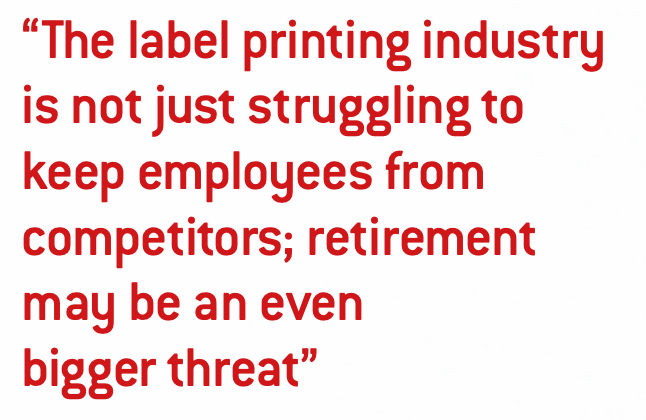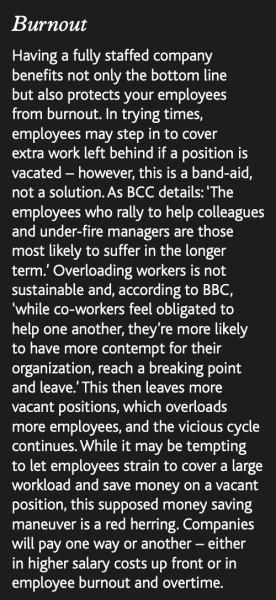The path to success

The labor market continues to shrink. The ‘Great Resignation’, which began in spring 2021 in the United States, has left employers hard pressed to fill staffing vacancies. As workers can afford to be choosey in terms of employment, companies need to up the ante in terms of offerings. One way to do this is by clearly defining career paths within the organization to both attract and retain employees.
In current hiring conditions, employers need to mind that interviewees could be in communication with several companies, and potentially entertaining multiple job offers. As an employer, you need to differentiate yourself. By showing a potential employee what their career path could like look within your organization, they can envision a successful career for themselves at the company. As Claudia St John, president of Affinity HR Group, says: ‘Whether you are trying to attract talent or keep talent, nobody wants to think that what they are doing at this moment in time is what they are going to do five days a week for the rest of their lives.’ However excited your potential hire may be about the position, they will eventually want more from their career. Laying out a clear career path demonstrates that your company can offer a fulfilling employment environment in the long run.
Affinity HR recently encouraged their clients to ‘visualize the talent they seek and work to understand what their desired employees are looking for’. St John cautions: ‘Too often, business leaders fail to recognize the unique needs and wants of their talent and focus instead on what they as employers want.’ Now more than ever before, those hiring new employees need to recognize what their potential and current employees need and want if they want to grow and retain their workforce. While employers may be able to hire someone for minimum wage, that may not be a wise decision for the business in the long run; hiring new employees is not just about getting people, it is about getting the right people.
 However, hiring new employees may prove to be easier than retaining current ones. Even before the ‘Great Resignation’, employees knew that the best way to get ahead was often by abandoning ship at their current company. As HR company Lattice detailed, Glassdoor found that ‘73 percent of employees change employers to get ahead in their careers, while only 27 percent of employees stayed at their current employer for their next role.’ Lattice elaborated: ‘Having a detailed framework in place makes it easy for employees to understand which of their skills are transferable to other departments and roles within an organization, and encourages internal career changes.’ If employees see a clear path at their company, their eyes may not wander to other employers.
However, hiring new employees may prove to be easier than retaining current ones. Even before the ‘Great Resignation’, employees knew that the best way to get ahead was often by abandoning ship at their current company. As HR company Lattice detailed, Glassdoor found that ‘73 percent of employees change employers to get ahead in their careers, while only 27 percent of employees stayed at their current employer for their next role.’ Lattice elaborated: ‘Having a detailed framework in place makes it easy for employees to understand which of their skills are transferable to other departments and roles within an organization, and encourages internal career changes.’ If employees see a clear path at their company, their eyes may not wander to other employers.
The label printing industry is not just struggling to keep employees from competitors; retirement may be a bigger threat than competition. With an older workforce, succession planning for roles company-wide is crucial. If employees are laying out career paths for all of their employees, then it is easier to see who is eligible to move into a new role when another employee leaves or retires. As Glassdoor explained, with career paths ‘you can have candid conversations with employees about future planning and invest in their journey to develop the skills and knowledge needed to fill highly-specialized senior positions.’ This is one way to close the knowledge gap in the print industry.
HR perspective
To get an HR professional’s perspective on career planning, L&L spoke to Claudia St John to get her input on career planning in the current labor market.
‘The labor pool is shrinking so there is always going to be a tight race for talent; if all you are doing is trying to take somebody and plunk them in a job and give them ten more bucks an hour, you aren't going to keep them,’ says St John. ‘I think everything is on the table. Employers should be looking at career paths, succession planning, compensation, perks, benefits, workplace structure, scheduling, hybrid, you name it.
‘In this time when it is very hard to find talent, having a clear, intentional development plan for your workforce is an asset. Everybody wants to know how they can grow professionally and being deliberate and intentional about that growth through finding mentors, identifying key tasks and responsibilities that will get you to the next level if you achieve them, and seeing where your progression can take you is fundamental.’
St John emphasizes that a career path is a way to stand out from a crowd of competing employers. ‘If you are just chasing the almighty dollar, there will always be somebody who can pay more. But that doesn't mean that people won't be happy working for you. There is more you can offer culturally and in terms of opportunities.’
However, many companies are not making the opportunities within their business known, or are failing to appropriately plan for position vacancies. ‘I have seen lots of companies do this poorly because they are not intentional,’ said St John. ‘A lot of employers will have a vacancy and then look to see who to plunk into that vacancy without the idea of systemic succession planning all the way around.’
Conversely, some companies excel at career path planning. ‘I have seen companies do it really well. First, they invest in their managers so that they have solid training and know what it takes to be a good manager. That’s the first step. Then they identify a few candidates who would be good to grow in their roles and have those intentional conversations around career path.
‘I've used this word a couple times: intention. Often people grow up and develop a career path that is sort of accidental. Being intentional about developing your people will give you a bigger bang for your buck, because then those folks know there is a program and a path. If they are on the wrong path, then they can figure out what they need to do to get on the right path.’
Ultimately an investment in career paths is an investment in the company, according to St John. ‘The important thing that I want folks reading this to know is when you invest in career paths you are investing in your company. Those dollars go directly toward growth and prosperity of your company because whenever you develop people, you get their knowledge, perspective, commitment and support.’
Yerecic Label
One company that understands the value of a clear career path is Yerecic Label. When hiring production workers, the company outlines a clear career progression which moves them up through the ranks of equipment with compensation increases at each stage.
Asked why Yerecic Label started defining career paths, Elizabeth Yerecic, key account manager the converter, says: ‘The market for labor became a lot tighter over the past few years and we wanted to be more attractive to applicants, particularly on our production side.
 ‘This was also partially due to listening to the feedback from our current employees. Often when someone would go on vacation, another person would be asked to fill in. There was feedback that they wanted to be compensated for that specific work since it was a different level of training or a different piece of equipment. We felt that there was value in the cross training that they had so we took that in and looked at what we could offer to new hires as well.
‘This was also partially due to listening to the feedback from our current employees. Often when someone would go on vacation, another person would be asked to fill in. There was feedback that they wanted to be compensated for that specific work since it was a different level of training or a different piece of equipment. We felt that there was value in the cross training that they had so we took that in and looked at what we could offer to new hires as well.
‘Our VP of production, Brian Hurst, reviewed all the equipment within our facility and created different levels according to operating difficulty from start to finish. You are being paid for your knowledge here and that is extremely attractive to a lot of people, especially in the trade world.’
Introducing this type of structure has also led to better quality hires, according to Yerecic. ‘In our industry right now, with so many changes not only in digital but in flexo too, technology is always improving so we’re happy to reflect that in the way we pay people. Creating a clear career progression path was a natural step toward attracting the right type of people into our environment that truly want to learn more and are willing to grow with us as a company.’
This has not only helped recruiting, but also retention. ‘Retention is where we are going to see some of the biggest impact,’ says Yerecic. ‘It is great to bring people on but, specifically in our industry, the training is so important that when you lose someone, it really hurts.’
She continues: ‘Having an impact in saying: if you cross train here, here and here, then we are going to pay you for all of that effort, goes a long way towards A) showing respect to the employee and what they are doing for you by furthering their education and B) it helps them want to stay because they have the opportunity to earn more money and grow their career.’
For Yerecic Label, this program keeps the company agile by protecting against knowledge gaps. ‘If you have a lapse in knowledge on equipment you see it in your throughput. You have extended lead times and unhappy customers. Being able to move people around is particularly important for us to stay agile as a company.’
Implementing career paths
Creating a career path structure can have significant benefits, so how can a company start creating these paths? St John advises asking your employees for help. ‘As employers, we often feel we need to have all the answers, but often the people who have answers are the ones doing those jobs. If you don’t know how to create a career progression within your company, ask the people who have done it. Ask them what they needed and how they grew. If you have someone who is now a vice president, what did they need to learn and how did they learn it and who taught them? Build that career path intentionally from that.’
Glassdoor has outlined some tips to creating a clear career path. The first step is outlining ‘all the core competencies required for each career path and identify potential cross-departmental movements’. Once the core competencies are defined, create benchmarks for each position and clear progression steps.
 Once the plans are solidified, share them with the organization. This can be done with new hires during the interviewing process, so potential employees ‘know from day one that your company is invested in their growth and wants them to have a long, successful career with your organization,’ as Glassdoor states. ‘For existing employees, make sure the information can be easily found so employees can chart their own career paths and identify personal growth opportunities.’
Once the plans are solidified, share them with the organization. This can be done with new hires during the interviewing process, so potential employees ‘know from day one that your company is invested in their growth and wants them to have a long, successful career with your organization,’ as Glassdoor states. ‘For existing employees, make sure the information can be easily found so employees can chart their own career paths and identify personal growth opportunities.’
Ultimately the Society for Human Resource Management found that creating career paths may have ‘a direct impact on the entire organization by improving morale, career satisfaction, motivation, productivity, and responsiveness in meeting departmental and organizational objectives’.
If your company has not started creating defined career paths and investing in succession planning, now is the time to start.
For further info:
For more information about Affinity HR, visit: affinityhrgroup.com
Stay up to date
Subscribe to the free Label News newsletter and receive the latest content every week. We'll never share your email address.

